Siona Benjamin’s Megillas Esther
There is nothing funny about Siona Benjamin’s Megillas Esther (2010). Unlike some contemporary illuminated megillas that emphasize the absurd and outlandish nature of the corrupt Persian court and the buffoonish character of the king, Benjamin takes the Book of Esther quite seriously. She is obviously deeply sensitive to the terrible consequences of God’s hester panim (hidden face) in our own time. Benjamin, a well-known Bene Israel artist originally from Mumbai, India, presents us a singular perspective on the Esther story. Set in the visual context of traditional Indian/Mughal miniatures and infused with imagery from her extensive artwork on Jewish themes, this megillah casts the narrative into a potent brew of exoticism and violence.
Her illuminated scroll is eleven and a half inches by fifteen feet long, created over a year and a half in gouache (opaque watercolor) on a parchment prepared in Israel. She worked closely with both her anonymous patron and teacher Rabbi Burton Visotzky (JTS) to develop a megillah that was informed as much by traditional commentaries, her own Jewish/Indian background and contemporary experience.
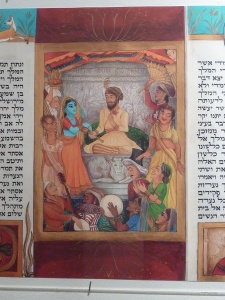
Benjamin’s images start innocently enough with a scene of the King enthroned amidst his royal court. One immediately notices the piled-up style typical of Indian miniatures, depicting the turbaned court sages and satraps, including a red-cloaked Haman, all toasting a dancing girl and her drummer. Her exotic pose evokes a flying angel, alerting us that this is no ordinary banquet and alluding to the unfolding narrative of Vashti’s shocking rebellion. A cameo of Queen Vashti is seen below.
The artist intersperses seven full miniatures between three columns of text each, framed by a solid decorated border above and three rectangular panels of decoration and narrative images below. Additionally she has symbolic images (a brush, a sword, birds, flowers, etc) flowing between the textual columns as a decorative visual commentary. The effect is hypnotic, calming turquoise borders punctuated by vivid greens and russet earth colors of the illuminations create a vibrant frame for the megillah text written by an Israeli scribe.
The intrusion of threatening long sabers, beautiful exotic birds, peacocks, elephants, deer, gazelles and lions along the top decorative border creates a subliminal counter text that becomes more strident, finally with fire-breathing dragons and prancing camels toward the narrative’s conclusion. It is as if the natural world with all its mysteries is observing and commenting upon the deeply human story of Esther and her struggles to save the Jewish people.
Esther Presented to King Ahasuerus is a richly oriental scene crowded with no less than 14 figures. Nonetheless, all is not secure as we see among the crowd and musicians the mysterious eunuch Harbonah and the evil Haman, characterized by a handlebar mustache straight out of classic Bollywood thrillers.
Not surprisingly, Esther dominates the large miniature panels, establishing the narrative primacy of her role. The seven full panels illustrate: Ahasuerus’s Banquet, Esther Presented to the King, Esther’s First Banquet, Esther’s Confrontation with Haman, the Triumph of Mordechai, Hanging Haman’s Sons and finally the Triumph of the Jews directed by Esther and Mordechai. What is most singular about the artist’s depiction of Queen Esther is that she is blue. This is Benjamin’s signature symbol of a unique individual, set off from mankind, alone in piety and determination, and almost goddess-like in her attributes.
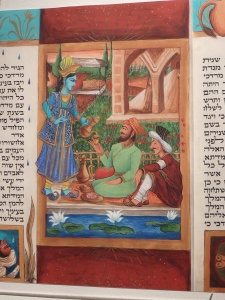
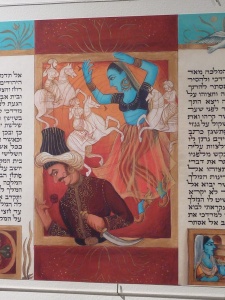
The fourth panel of Esther’s First Banquet is one of the most stunning images in this megillah, fully evoking its sumptuous Persian miniature forbearers. The King and Haman are seated alongside a fragrant lotus pond being served by a celestial Queen Esther. She is wearing a beautiful elaborate costume, elegant blues embroidered with silver and gold. In contrast to the seated King and Haman, she practically floats into the scene. Vashti even makes a surreptitious appearance under an arch in the building behind them. In the artist’s vision, Vashti, even though removed from power, hovers in the background watching the drama unfold.
Esther’s Confrontation with Haman is a hallucinogenic vision of armed horsemen attacking a swirling Queen Esther as the wicked Haman crouches in the corner, his curved knife ready to slaughter any Jews he can find. The vivid crimsons and oranges vibrate against the blue Esther and the pale ghostly riders to create a Hitchcock-inspired nightmare.
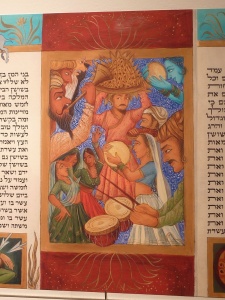
These lush illuminations are simply a prelude to the visual climax of this megillah, the Hanging of Haman’s Sons.
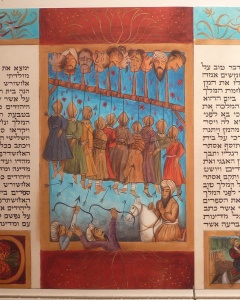
Aside from the fact that as sons of Haman they were also Amalakites, the Seder Olam (Rashi on Megillah 16a) tells us that they had instigated the decree of Ahasuerus to halt the rebuilding of the Holy Temple, thereby condemning them to death at the hands of the triumphant Jews. Set against a vibrant blue sky the evil sons are executed in three explicit ways. Primarily we see all ten hooded and hung in a row on one beam. To drive home the notion that each was individually evil, their ten heads are impaled on gruesome stakes attached to the top of the beam. And finally, just to add insult to execution, two archers shoot arrows into their bodies under the direction of Mordechai. This last detail of the image finds its precedent in an equally vivid 17th century Judeo/Persian manuscript.
Curiously following the execution of Haman’s sons in one of the small border panels is a scene described as the Circumcision of the Gentiles. It elaborates on the verse 17, chapter 8 that “many from among the people of the land professed themselves Jews; for fear of the Jews had fallen upon them.” Josephus (Antiquities XI) comments that in order to do this they “circumcised their foreskins…” However we see in Yevamos 24b that “Neither… nor the converts of Mordechai and Esther are proper converts unless they become converted at the present time (i.e. without coercion – Rashi).” But what prompted the artist to depict three clothed men from the waist down, spurting blood as a result of three gruesome knives? It would seem that Benjamin has taken the verse to mean that the Gentile circumcisions were in fact a kind of punishment on very real enemies of the Jews who tried to escape their fate along their fellow conspirators. The artist further drives home her point that the Jew’s enemies are doomed in an exceptional illumination within the text itself. In the space created by classic listing of Haman’s sons she has placed a red-robed figure hung and suspended over a roaring fire.
Siona Benjamin’s megillah illuminations do not flinch from the violent retribution the Jews of the kingdom visit upon their many enemies. And while the final large panel depicts the Triumph of the Jews as a musical celebration complete with hamantashen, drums, horns, dancing and timbrels, it is surrounded by no less than four images of retaliation. And of course this accurately reflects the overwhelming subject of the end of the Book of Esther. Chapters 9 & 10 concern themselves with exactly this retribution as “…the Jews struck at all their enemies with the sword, slaughtering and annihilating; they treated their enemies as they pleased” (9:5). The fact that the megillah enumerates the death of 75,810 Jewish enemies is seldom depicted with such force and originality.
One of the more fascinating elements in this megillah is the consistent representation of Haman in profile, always glancing out at the viewer. Only once, in the triumph of Mordechai scene, does he not look at the viewer, although still depicted in profile. While the uses of profiles in the representing individuals are many, usually that specific form represents a cypher of the individual, i.e. a one-dimensional cutout image. It is as if Haman, the epitome of evil, can only be known superficially. That said, as he glares out at us, he is especially dangerous.
While Benjamin’s megillah is lushly beautiful to look at, a very serious message is subtly weaved into the fabric of the Persian/Indian images and sacred text. In a faraway time an evil man arose who planned to destroy all the Jews. By the intervention of a brave, beautiful woman was the plot uncovered. Ultimately the disaster was averted only by the annihilation of our enemies. And then we were free to celebrate. Today, as our enemies continue to rally, perhaps we need to ponder the lessons of this megillah.
Siona Benjamin’s Megillas Esther
Hebrew Union College Museum
One West 4th Street, New York, NY 10012; 212 824 2205
Free Admission (Photo ID required)